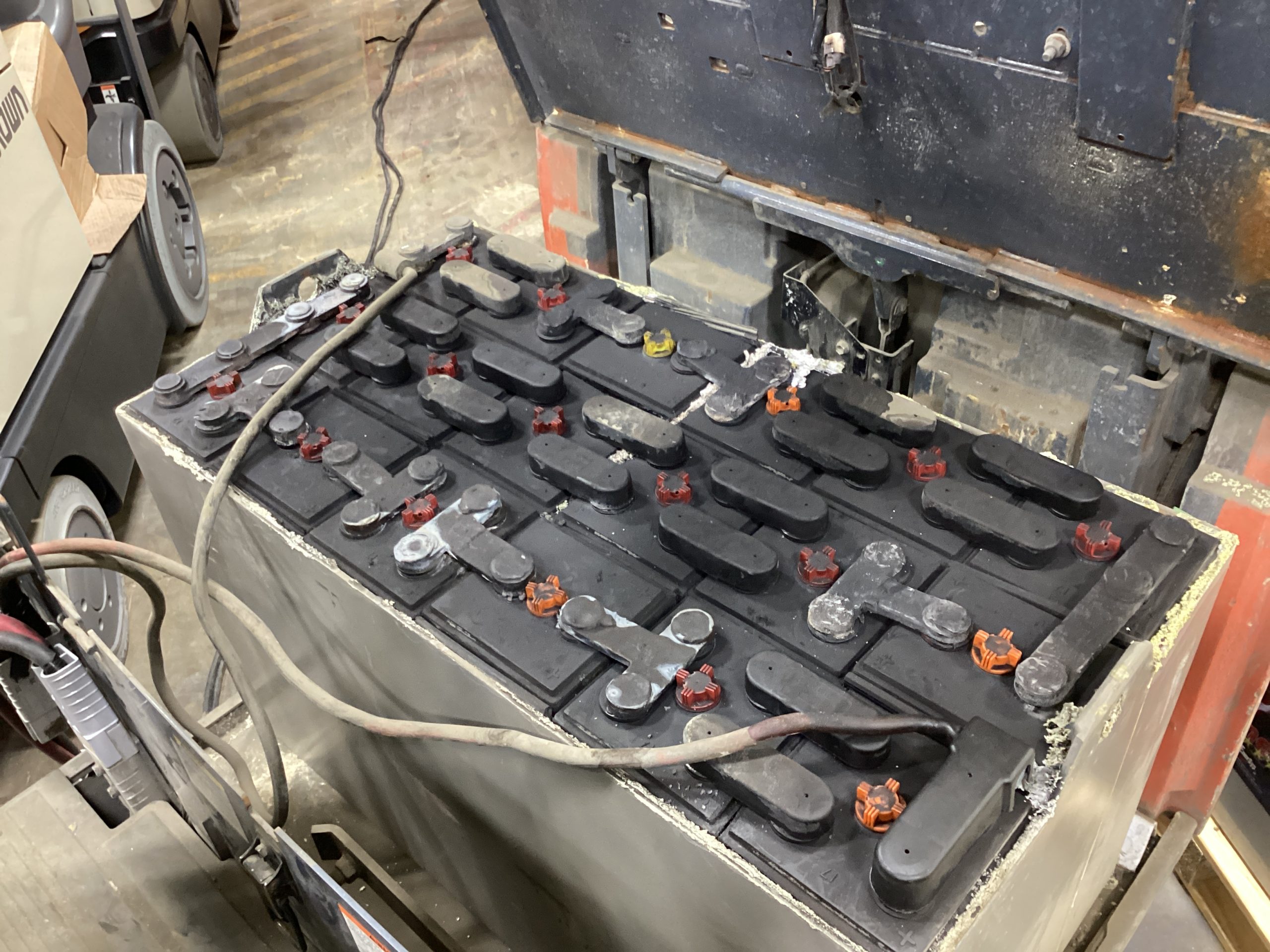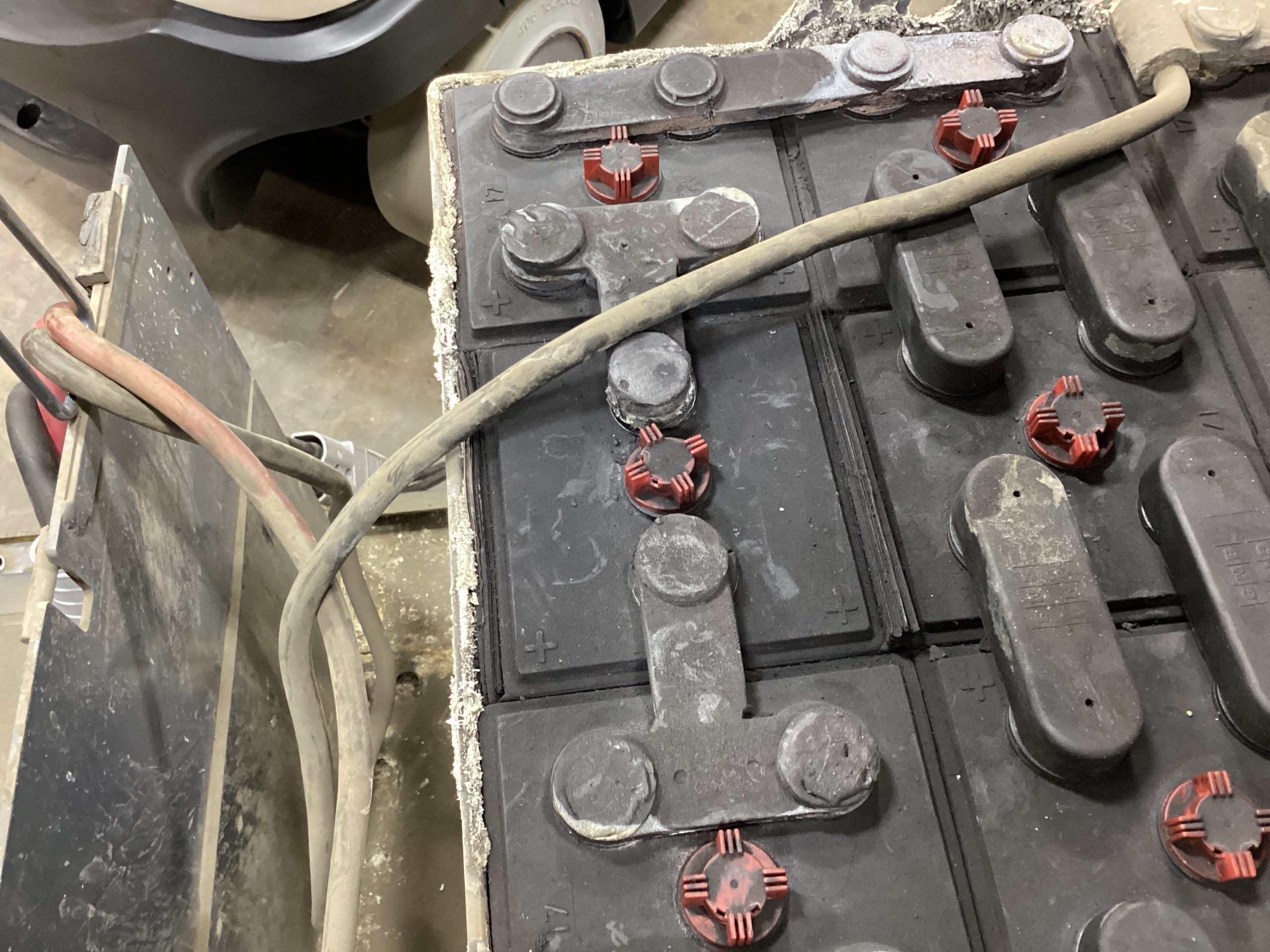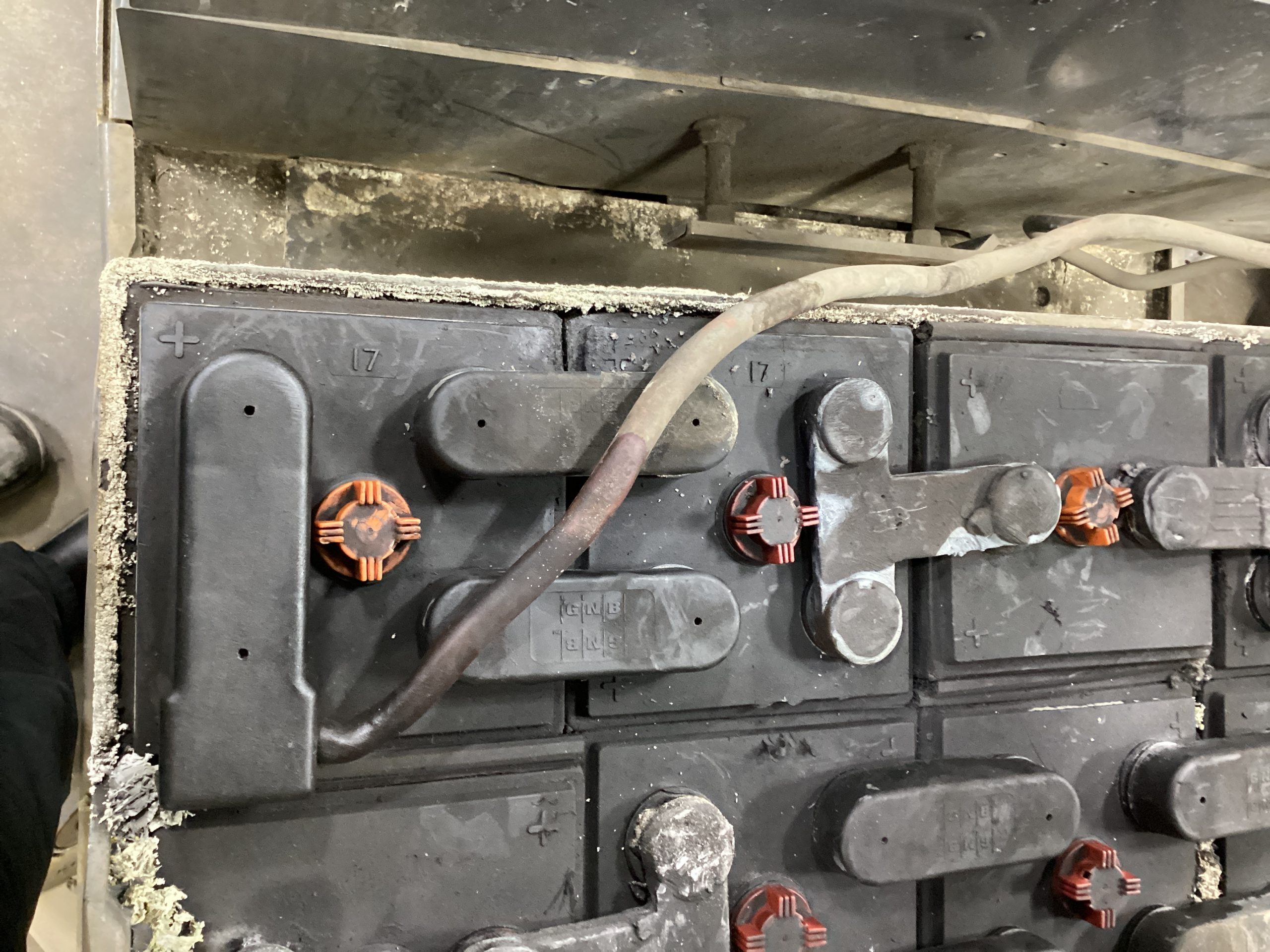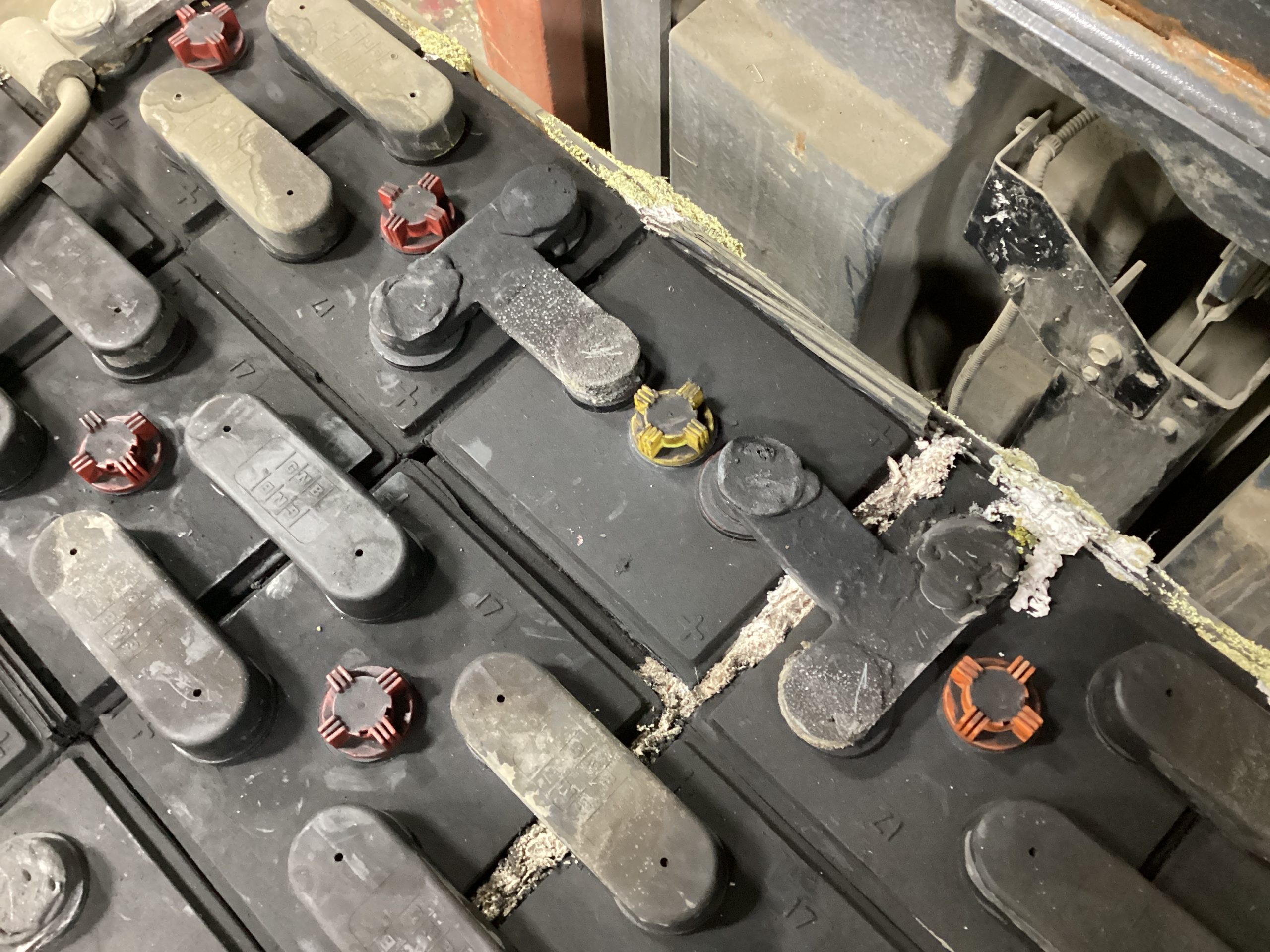
Toyota and custom colours
June 22, 2022We offer battery and charger service!
May 2, 2023Welcome to our spook-tacular Focus On! This month we're going to be looking at batteries and their maintenance, because there are few things more important to an electric forklift than what makes it go.
As the material handling industry moves more and more toward electric lift trucks for reasons like cost effectiveness, ongoing maintenance costs, and "fuel" cost/efficiency, batteries are becoming a more and more important part of everyday business. Because of that everyone is having to get a lot more familiar with what it takes to properly order and care for these hefty parts of business. Lucky for you we're here to help with every step of the process from initial ordering through to care and supplies, so don't hesitate to contact us!

What the heck is that?
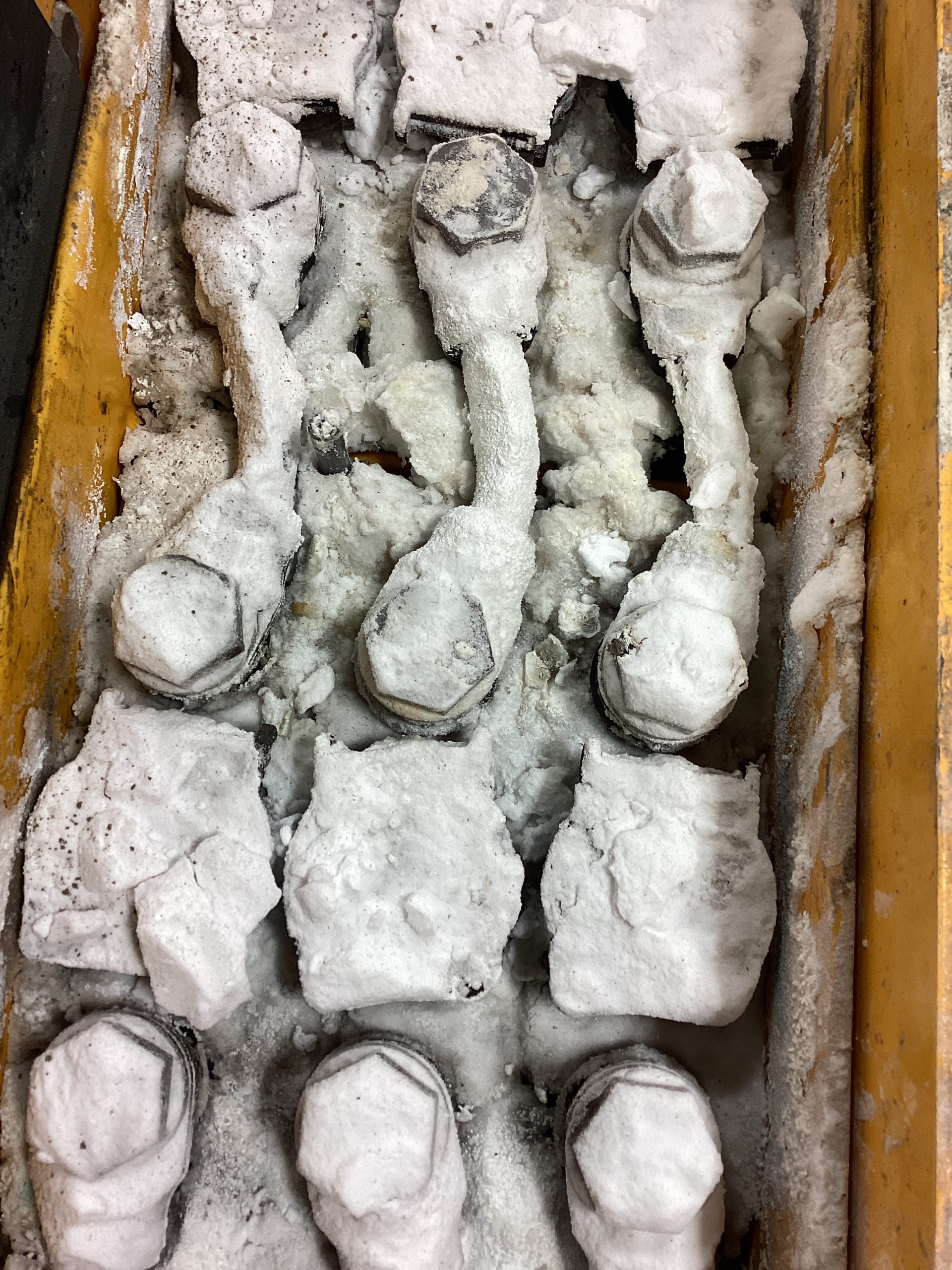
Crusty Details
So first a horror story, because Halloween is just around the corner
If you deal with batteries on a regular basis there's probably a part of your brain screaming in disgust after seeing this image. Don't worry! That's a perfectly normal response to lifting the cover on this monster and seeing what lurks within.
This is a customer battery that we don't quite have the full story on (sometimes the person in charge doesn't even have the full story), but what we think happened is a tale of terror in two parts. First: the battery was probably over-watered before being charged; this results in the battery acid boiling out of the cells while charging (adding energy causes materials to expand). Second: on seeing the top of the battery completely submerged in battery acid someone dumped baking soda all over it to neutralize the acid, which is actually not a terrible call but ends up looking like this.
Unsurprisingly we're working on this walkie jack because of "battery issues."
Part of this problem could be solved with better training and education of those taking care of the battery. Part of it could have been helped by having a good spill kit on hand to deal with the problem effectively instead of "WhatdoIdo?" in a panic and grabbing whatever is at hand.
For the training and education side batteries are actually pretty simple.
- Make sure the battery and charger are right for each other: part of this is in the ordering process. Making sure that the right charger gets paired with the right battery can mean the difference between an expensive, smelly paperweight and an effective battery that does what you need. If a charger has too much capacity or hasn't been configured correctly it might be over-charging your battery; this can reduce the useful lifespan pretty quickly. On the flip side if the charger isn't big enough your battery will never get a full charge, which isn't good for it either. Customers with multiple trucks and incompatible chargers sometimes use different colored SB connectors to make sure the wrong truck doesn't get plugged into the wrong charger, but many also stick with a clear numbering/pairing system to make clear which goes where.
- Batteries are watered AFTER charging: one of the most common mistakes people make when charging is topping up the battery before throwing it on charge. Especially if the water is brought right up to the fill hole this will often result in the battery acid boiling over and covering the top of the battery before seeping down between the cells. This starts forming a nasty crust on the surface, corroding the terminals and surfaces, eating away at the battery casing, and even damaging the forklift if left unchecked!
- Charge Cycles are important: For a conventional battery a charge cycle is this: 8 hours of charge, 8 hours of cool-down, 8 hours of use. With the right charger this means the battery has enough time to absorb a full charge, cool down/return to a normal state, and then work a regular shift. Exceptions to this rule exist, with Opportunity Charge and the newer Lithium-Ion batteries working on much shorter charge cycles. Lithium-Ion especially work well in situations where they can be parked for a few minutes here and there throughout a shift to top up a bit (breaks, lunches, etc...).
The other part of this is having a good spill kit on hand. Most of these kits are fairly similar in that they come in a bucket to store their contents and anything you need to clean up. Inside the bucket is usually some PPE (face-shield or goggles, gloves, and apron typically), something to soak up any spilled acid (absorbent pads or snake, or sometimes a granular absorbent), and typically a spray or solution to neutralize the acid (this will get down between the cells and into the battery casing as well instead of just a surface touch-up). Keeping this all in a bucket makes it really handy to grab in case of emergency, and means there's somewhere safe to store the clean-up until you can dispose of it responsibly (laws vary by location but you can't usually just toss it in the trash).
One of the things we pride ourselves at Industrial Truck Service is on making sure you have what you need to keep your business moving. Your CSS Rep will be happy to help you find the right products to take care of your battery fleet, from easy to spot battery PPE boards to watering systems, and even Periodic Maintenance by one of our skilled technicians. Our Sales Team is also available to help you make sure you get the right equipment, batteries, and chargers for your business needs.
Now to wash away the horror
Here we see a battery that has been taken care of properly. This is a big one out of one of our Toyota 80V Electric Pneumatic forklifts. Most industrial batteries for material handling uses have 2V cells, so this battery has 40 cells cells to hit that 80V size.
This is not a new battery (we've got pictures of that later on) but instead a real life, working battery that's even had some work done on it. Over-use by a rental customer killed a couple of cells, so our in-house technicians needed to replace them and do some work to bring the battery back to factory spec. Despite all that you can see how well it has stood up. Its been through a cleaning and a full diagnostic load test and has already been back at work in our rental fleet.
A couple of notes on this battery because there's kind of a lot going on in the picture.
- The black tubing with little red pips you see is a watering system; having a watering system can vastly decrease how much time it takes to water the battery. Instead of pulling each cap, filling each cell, replacing the cap and repeating 12-40 times, you can plug a single hose in and fill the battery in a fraction of the time and effort (and "time is money"). It also makes the process safer by reducing the chance that team members are exposed to battery acid.
- There's some cable management going on. Just a little with some heavy-duty electrical tape, but keeping the cables easy to handle can help reduce wear and tear on the cables and connectors. Do enough damage to the cables and you'll need to replace them: a process that requires drilling, new lead-head connections, molten lead, cables, and connectors. Better to just take care of them in the first place huh?
- On the connector front this battery is a little different as well. Most of us are familiar with the blocky, color-coded, SB style connectors. Because of its capacity however this battery was fitted with a "euro" style connector which is rated for higher current flow. There's a bunch of internal differences between the SB and Euro connectors, but in the end they're both just battery plugs. You do need to know what kind of plugs your existing chargers use if you're getting a new battery though, because otherwise you'll be replacing more connectors.
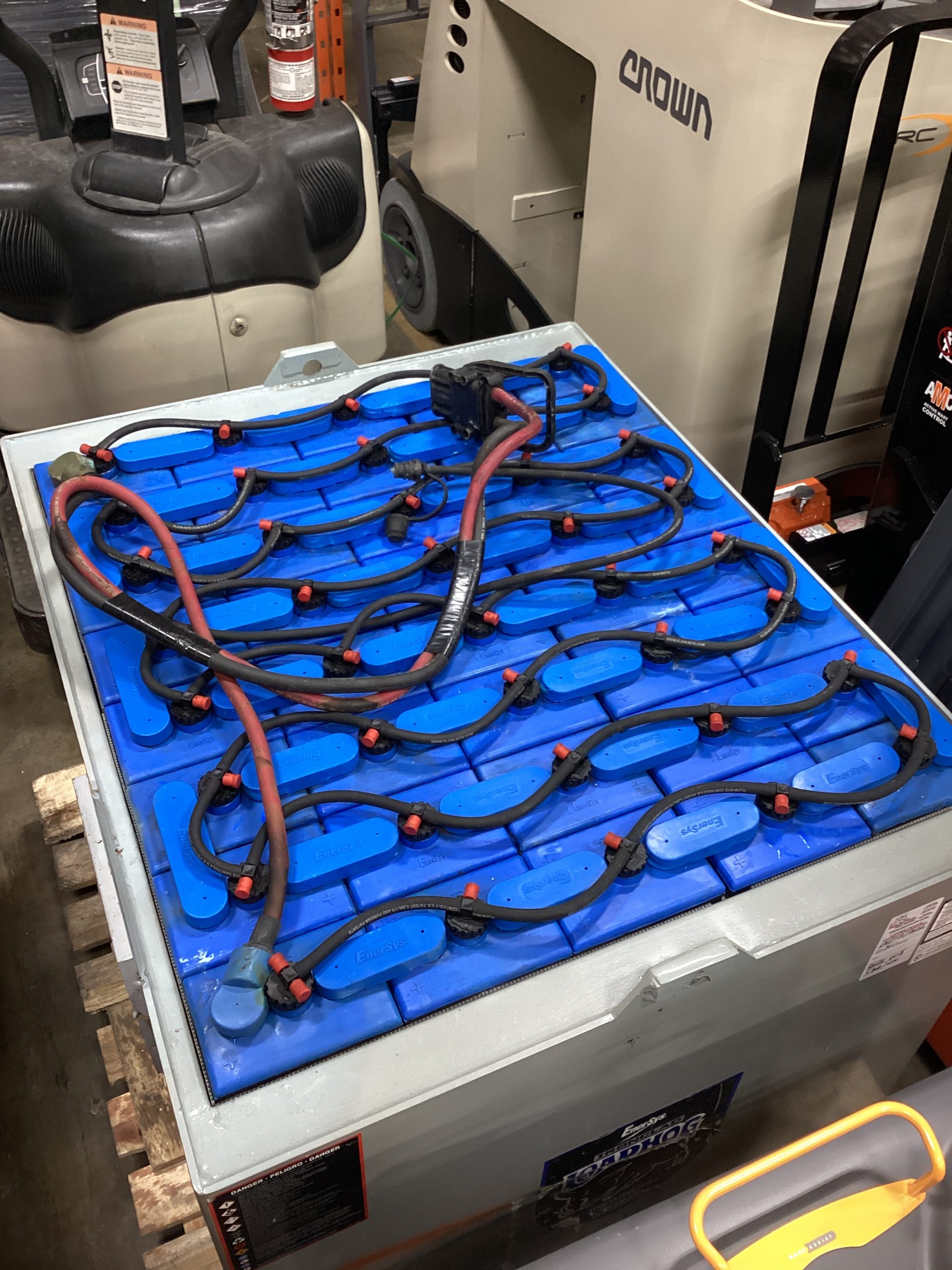
Used but cared for 80V battery
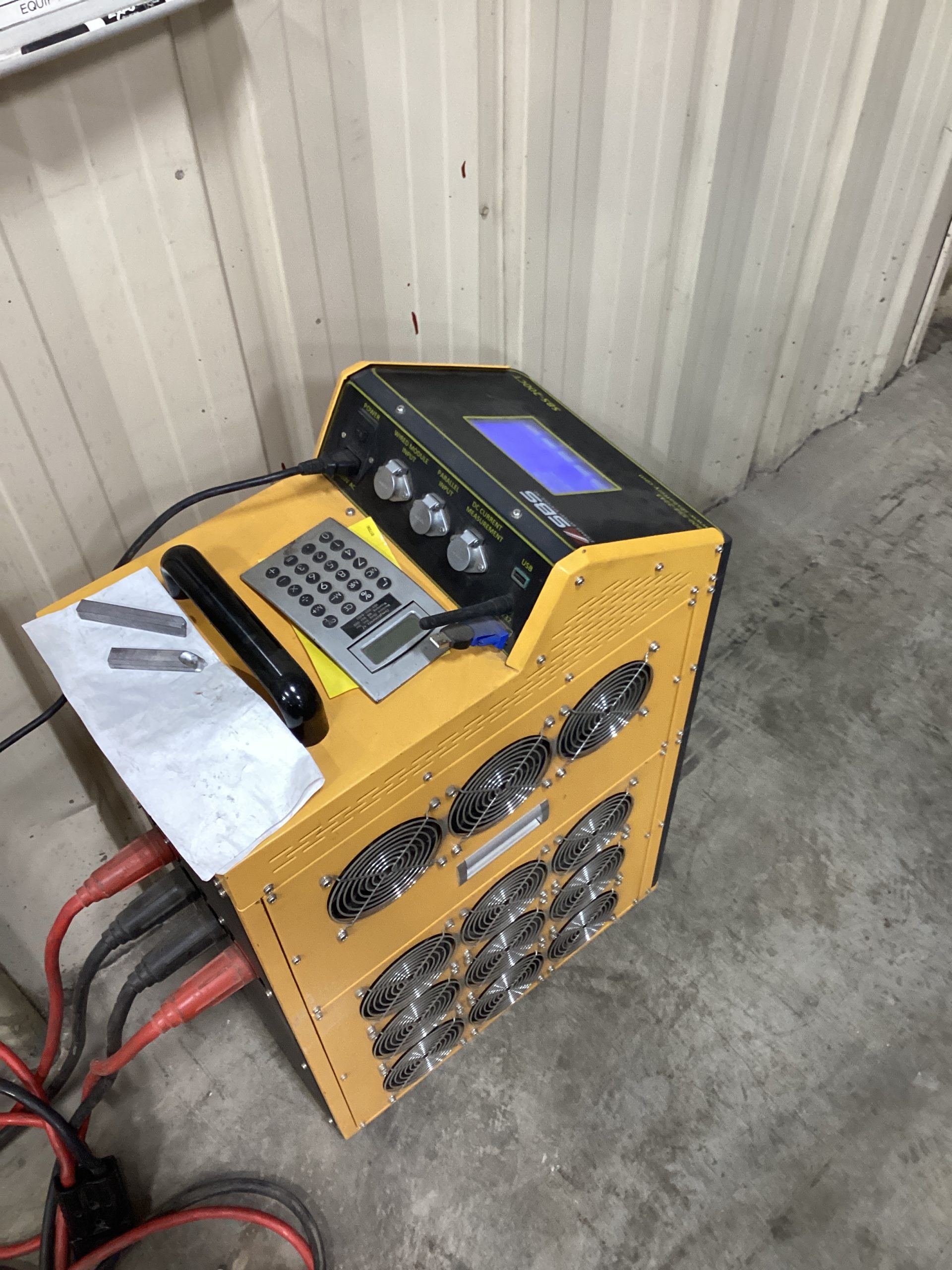
Battery Tester
Nobody told me there'd be a test!
A little earlier I mentioned our 80V battery being put through a test. While there are a lot of tests you can do with batteries like checking voltages and checking acid specific gravity to name a couple, to really test a battery and put some numbers to what you find you need something like this fancy little box.
Officially the SBS-200CT Forklift Battery Regenerator & Discharge Cycler this beauty can actually test each cell under load and charge and tell you where problems are with an underperforming battery (not pictured are the wireless sensor packs that need to be hooked up to the battery for testing). This also allows for unmanned regeneration charging where the system forces several charge cycles one after another in order to bring back some degraded capacity. How much this helps very much depends on how far gone a battery is, and isn't a replacement for weekly equalization charging.
Investing in this kind of equipment lets Industrial Truck Service do a deep dive into what's going on in your battery and can take you from "This battery is garbage" to "There's a pair of dead cells that need replacing" and since a battery is only as good as its weakest cell this can potentially save you thousands of dollars in unnecessary replacement costs.
Ideally you won't need to take advantage of this testing capacity by taking good care of your batteries in the first place, but if something does happen we're there for you to call if there are problems. This kind of testing is shop based however, so your battery will need to come to us. You can contact Your CSS Rep to see if we have a battery available for rental to keep you up and running in the meantime.
What's in a battery anyway?
I've mentioned battery cells, acid, and a few others things already in the article, but what are they all actually?
A few months ago we got some extra training from one of our vendors on their battery line-up and this cut-away view was just too awesome to not snap a picture of. This is from one of Crown's V-Force Batteries, specifically their Lead Acid Tubular Low Maintenance line. Within the cell you can see the plates (the tubes and grid-looking thing) within their protective dividers and substrate coatings. This is where the magic of the battery happens and what allows it to store energy when flooded with the right acid solution.
Above that are the battery posts which are how you actually get the power out of the battery. One post is connected to all the positive plates while the other is connected to the negative plates. Sitting between the two posts on this cell is one of Crown's V-Force Float Assemblies, one of their two in-house systems (the other is a barbed style valve and looks a bit different). If you don't have a watering system there will just be a cap here that you can look down through to see your battery level. A flashlight can be a good addition to your battery tools to make sure you get a good look.
The bottom of the float is actually your target level for when you're watering a battery, because you want the plates to be fully submerged after you've finished a charge. If you don't water to this level you're exposing the working surface of the battery to corrosion and oxidation that being covered would protect it from. And yes it sounds funny to be protecting something from corrosion when you're bathing it in battery acid, but "exposed" corrosion is the "wrong" kind for a battery!

Battery cut-away view

New 48V battery
How things start
First you saw a battery in need of help, then one that had been well looked after, and finally we get to one that is actually new!
This is a brand new 48V battery for a brand new Toyota truck. Like before this has got some cable management keeping things in place; it really can be this simple. A few zip-ties to guide the cable and a bit of tape is a solid start. A little harder to see is the shrink-tubing around the cable ends in the connector to reinforce the connection. The factory does it this way because the connector is the most handled part of the battery, constantly being yanked on for charging and hooking back to the truck. There's actually a lot of ways to reinforce these connections and can be a REALLY good thing to look at if your operators are less than gentle with connectors.
Different types of handles, clamps, connectors, cable roving, sheathes, and shrink tubing are all available to reduce the need to replace your battery cables or ends. If you're used to seeing line items like "Connector Housing SB350" on your invoices, it might be a sign that your operators are playing a little rough with your battery components.
Your CSS Rep can either help you directly or put you in touch with our Service Department to explore what might work for you. This might be different connectors, charger stands, cable pogos, or any number of other things that might simplify some of your battery related life.
Heavy is the heart of the machine
Batteries aren't just what makes your forklift go, they're also an important part of how it works. Most battery units have less of a back-end than comparable gas units; this is because the battery itself acts as part of the counterweight. This is also why your forklift's dataplate lists a minimum battery weight on it, because that battery weight was used to calculate lift capacity.
Especially if you're a 2-3 shift business running a fleet of forklifts being able to get batteries in and out of your machines is an important consideration. If you're a single shift, occasional user this will never come up, but given the charge/rest/use cycle we talked about before, being able to swap batteries is a huge thing to think about. Do you have space to lay out a battery room where machines can drive up to roll batteries in and out? Do you have enough batteries you need battery charge racking? Do you need a crane, or will a couple of battery trays do the job? We can help you decide and implement the right solution for your needs.
Beyond that is your truck fleet itself. Maybe you've got a mixed bag of things bought at different times from different suppliers. Maybe you have a unified fleet from a single brand. Either way there's probably stuff going on under your battery you haven't thought of that can help or hinder your battery operations. Below are a few examples.
Bare tray
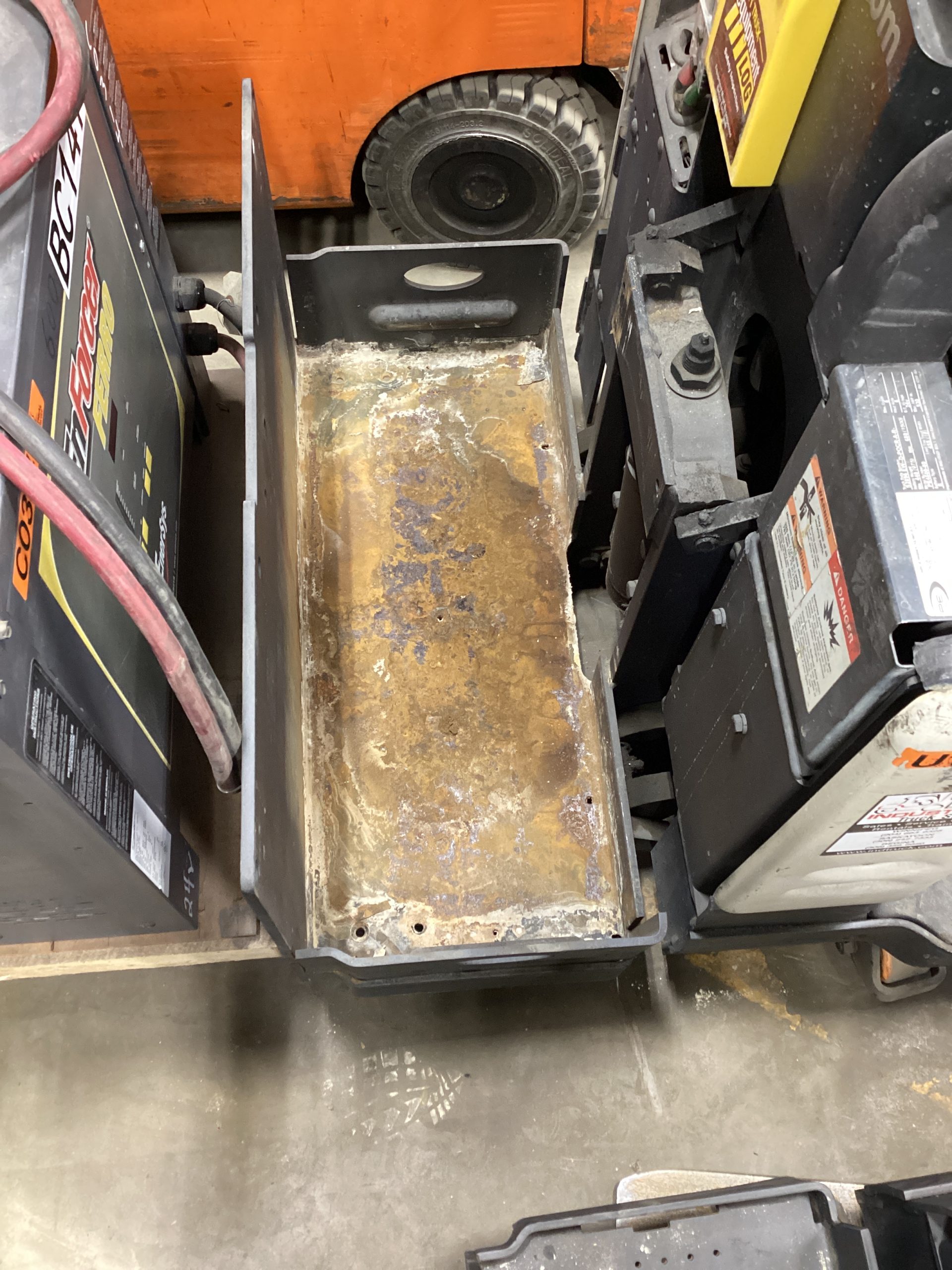
Base plate and stops
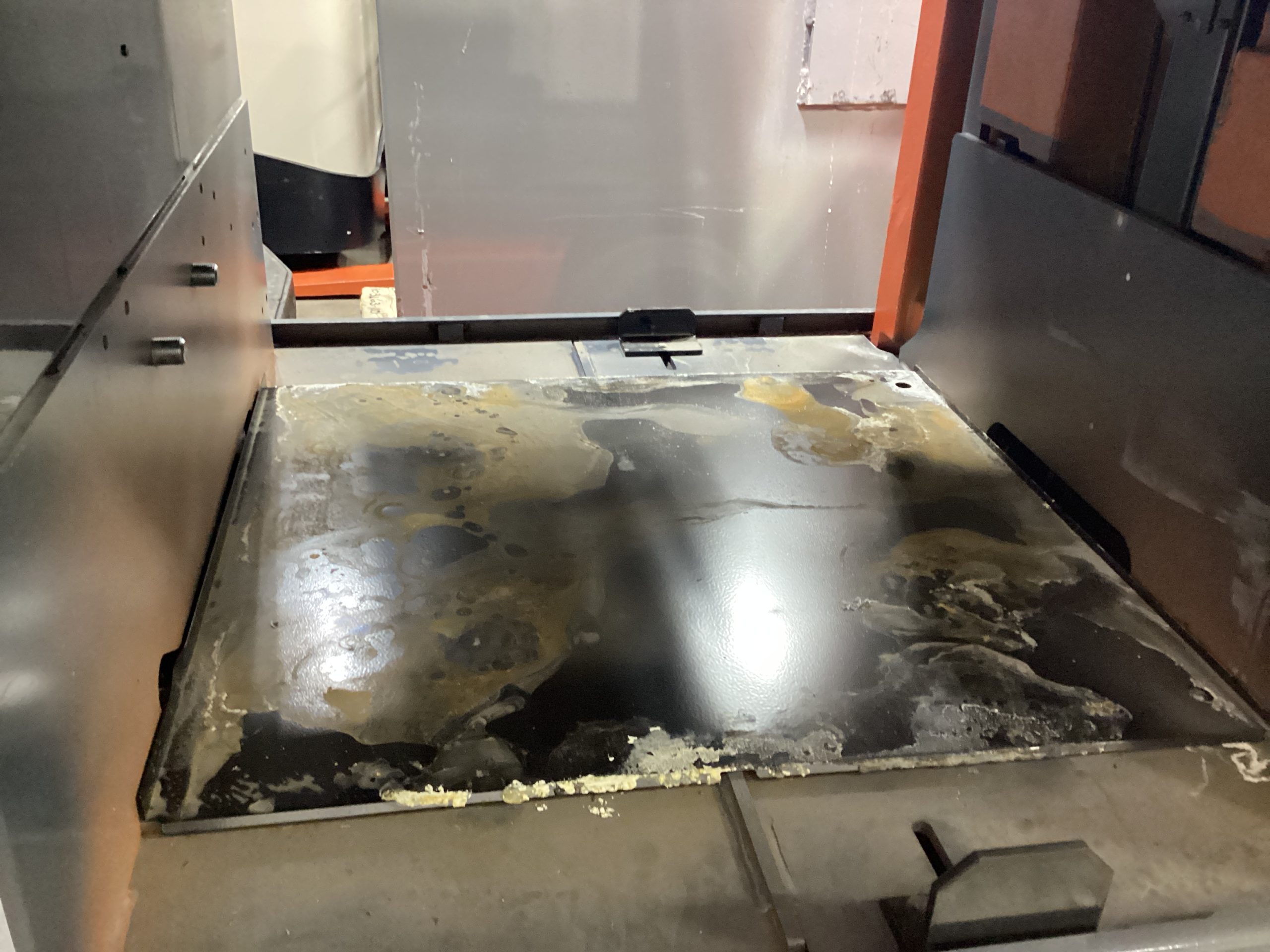
Battery Slides

Rollers

Just a few more things
Like many things about material handling equipment, batteries aren't short on upgrade potential. I'll give a short run-down on some of the most common below, along with a few more pictures.
- Blinky Lights: Blinky is actually a brand, but there are several others as well that accomplish the same function. Essentially a fluid level monitor, these little LEDs sit on the surface of the battery and have a probe inserted into a cell (typically a central cell). This probe detects the level of the battery electrolyte in that cell and when it does, starts blinking, or blinking a different color to notify that the battery needs to be watered.
- Watering systems: I mentioned it before, but there are several brands of watering system to help keep your battery topped up. Water deionizers, pressure systems, and many other options exist to accomplish the same task: making battery watering fast, easy, and safe.
- Battery Monitors: battery monitors are a system to help keep track of what your battery does and what happens to it, often paired with chargers and use tracking systems. Like the monitor lights and watering systems, there are several options to choose from on this front.
- Battery management systems: mostly intended for use on fleets running multiple shifts and swapping batteries, these management systems use lights or other types of indicators to show users which battery should next be put into use, taking the guesswork out of cool-down times and charge cycles to improve the useable life of battery fleets.
- Roving, Sheathing, and Heat Shrink: all of these are used to reinforce and protect battery cables from abuse by effectively armoring them against abuse. Some focus more on maintaining flexibility (sacrificing protection), some focus more on raw protection (sacrificing flexibility), and some are intended to reinforce very specific parts of the cables.
Below are a few examples of things for batteries that we wanted to show you but didn't really fit elsewhere.
36V and...

New-ish 48V battery

Corrosion beneath
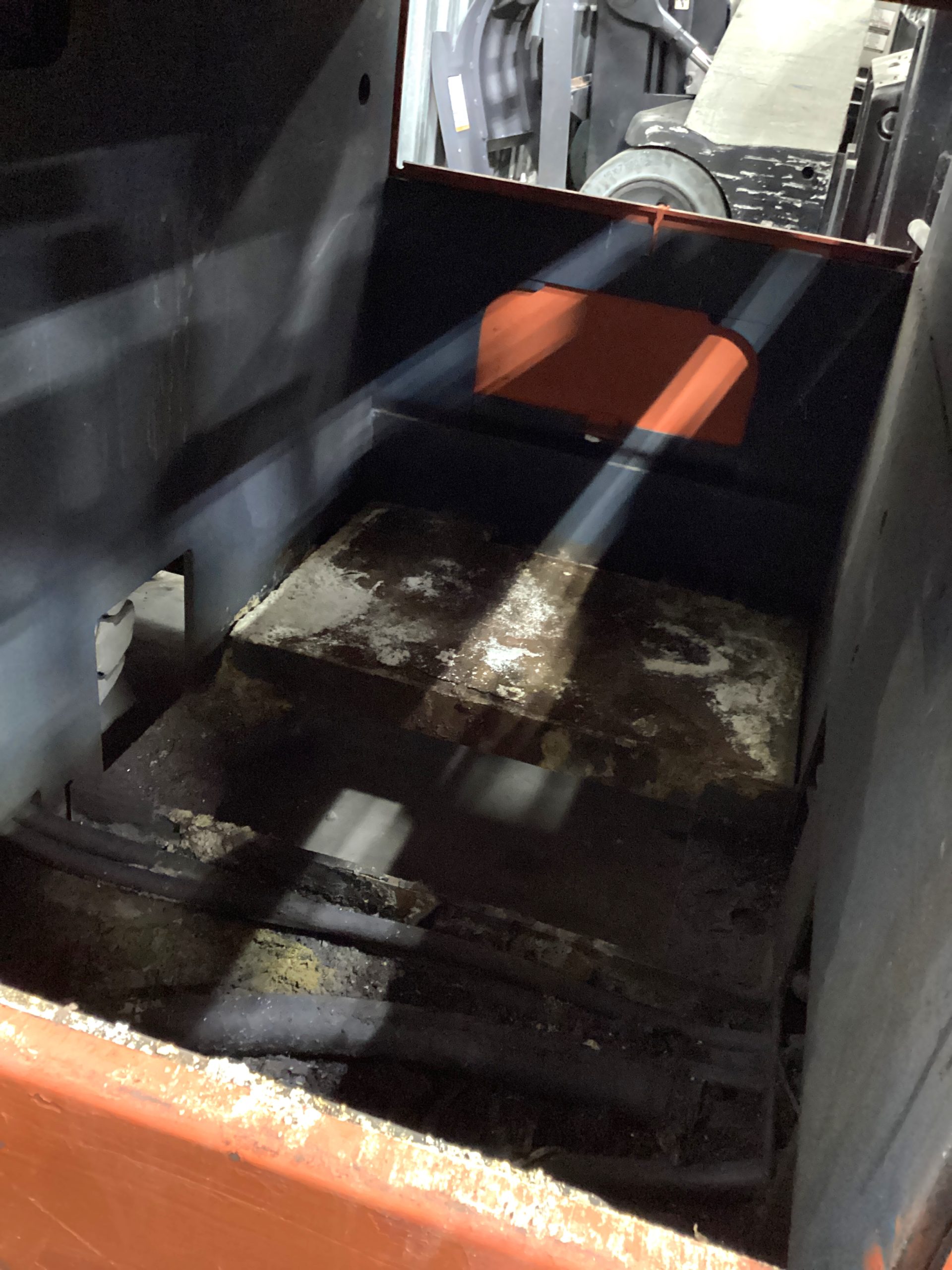
48V and...
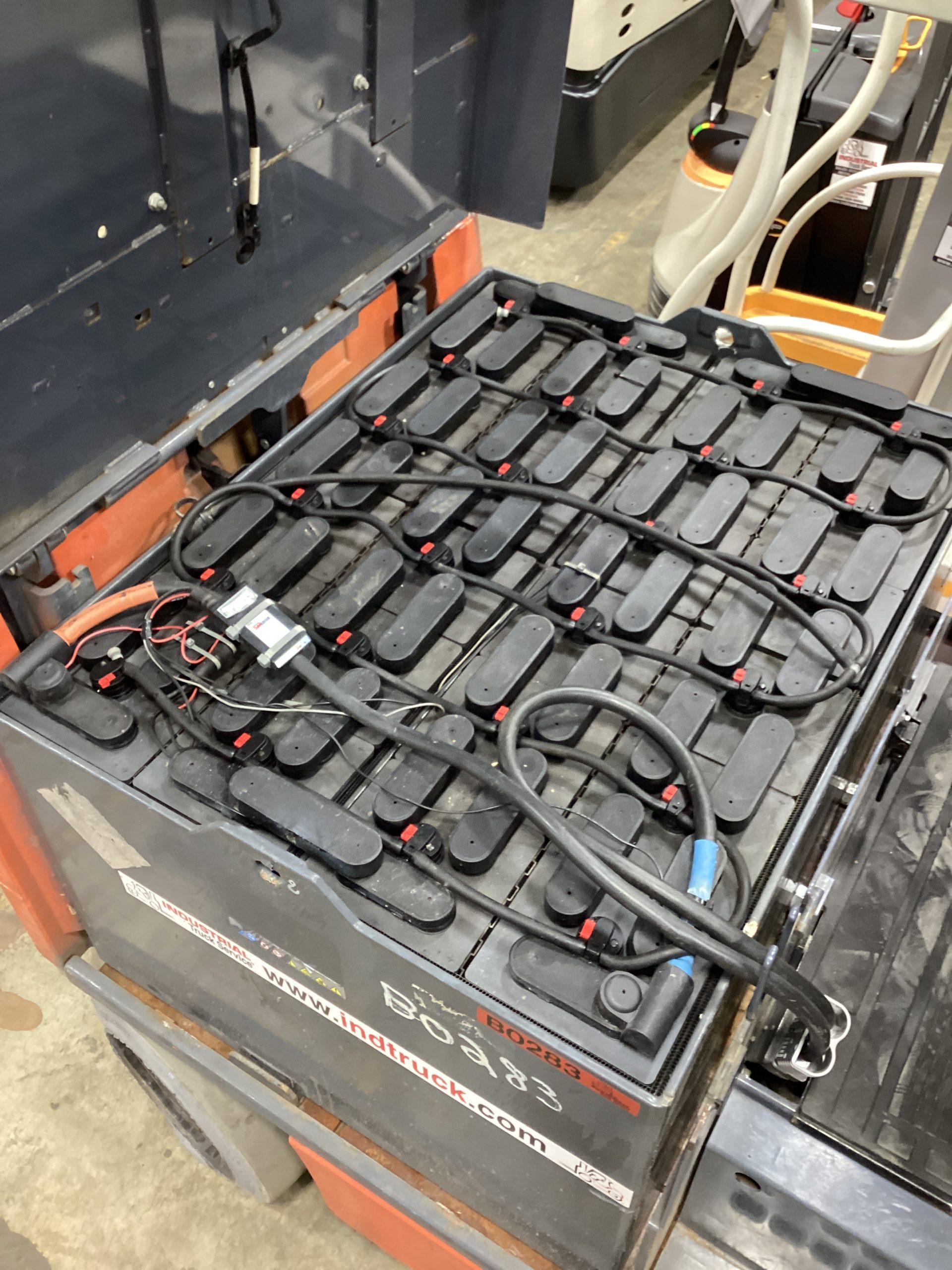
Opportunity Truck
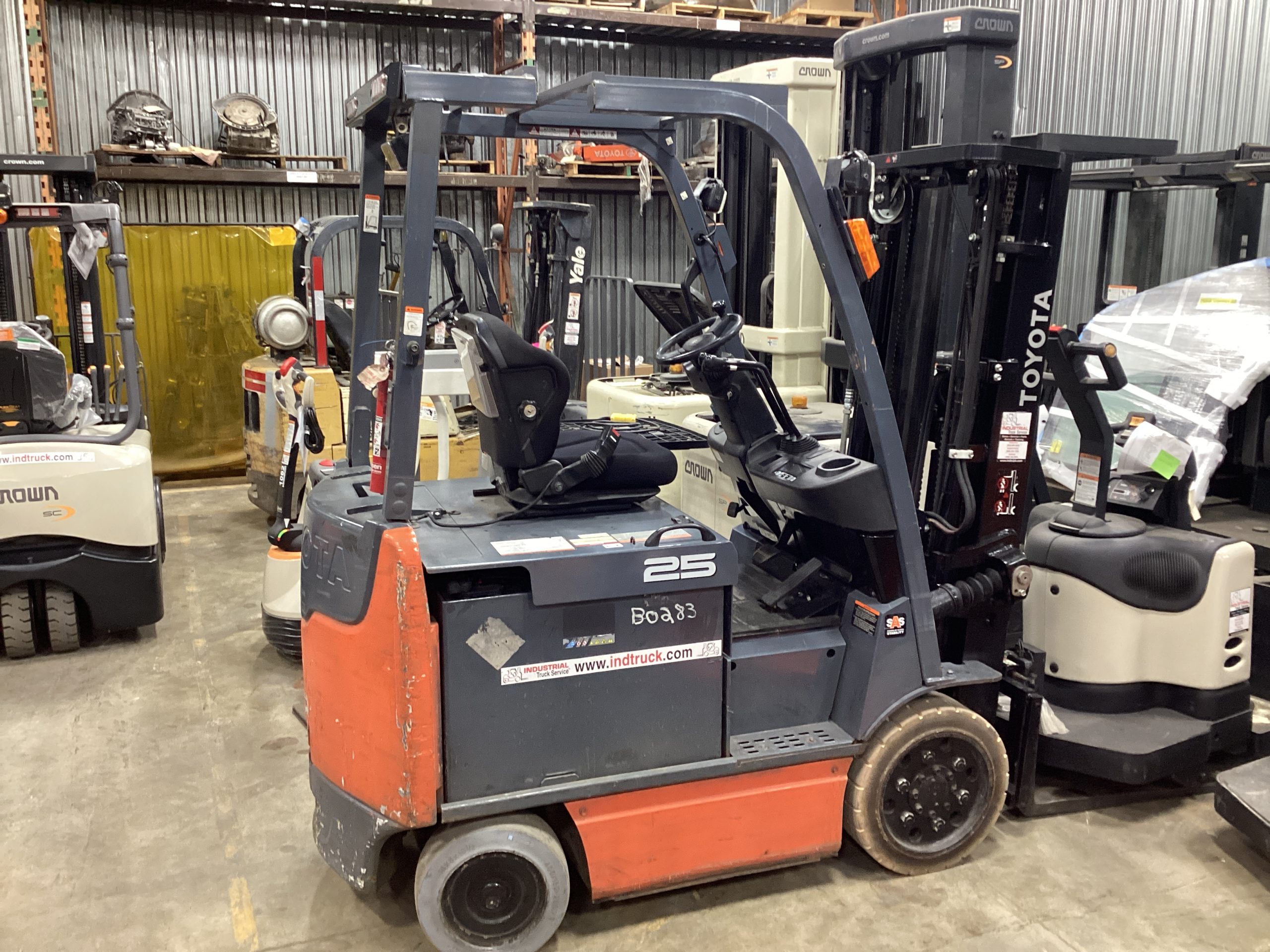
Behold The FrankenBattery!
This... abomination came in a while ago from a customer. They were complaining that the truck would drive only very slowly, had problems turning, and wouldn't lift or sideshift. As soon as it came in we knew what the problem was, but did some diagnosis to really nail down the cause of the problems. Hooking the truck up to a good battery from our stock suddenly let the forklift drive, steer, lift, tilt, and sideshift all at once! Behold, a battery problem!
This battery is not original, by any stretch of the word. It was apparently purchased locally from a vendor that is "reconditioning" batteries (we have some strong thoughts on this...). Looking closely you can see cells that are different sizes, different heights, and even different types of battery (some cells are the double-connector of opportunity charge and some are regular cells). The "T" connections had to be cobbled together by melting regular inter-cell connectors together, and there's obvious corrosion all over. There's also evidence of corrosion inside the cells as well, with some of the posts being pushed up by sediment collecting at the bottom. This causes shorting within the cell and basically guarantees the cell is dead as it becomes unable to hold a charge (let alone the safety risks of the short).
Less obvious, but we could tell from the cell markings themselves that these cells are even from different battery makers! All told there are at least 3-4 different batteries that have been bashed together to build this thing. To top it off the battery cables were so stiff that you could hold them out at a 90 degree angle without any drooping. They're supposed to be kind of flexible, not hard and brittle, and we suspect the cable has been over-heated repeatedly during charging so there's some doubts about the right charger being in use too.
You may also note that there's a lot of space between the front and back of the battery and the rest of the truck. This battery is in fact nearly 500lbs/227kg lighter than required by the manufacturers safety specifications. This means that nothing on the dataplate can be considered accurate for lifting or load specifications. And that's to say nothing of how unsafe something that heavy would be sliding around inside the body of the truck. Tip-overs, spills, injuries and even fatalities wouldn't be a question of "if" with this battery, but a question of "when."
This customer's CSS Rep had to tell them that not only was their battery shot (if it could ever have been considered "good"), but also inappropriate for their truck and that they'd need to get a battery with the correct specifications. In the meantime this truck is unusable both from a technical/usability standpoint and from a safety standpoint.
Please folks: if you don't know about something Get In Contact with us. We'd love to help you and your business find the right products for the right work. A little knowledge is actually worse than none, so call the experts and get our trained, knowledgeable, and experienced team working for you!
- FrankenBattery Image 1
- FrankenBattery Image 2
- FrankenBattery Image 6
- FrankenBattery Image 3
- FrankenBattery Image 4
- FrankenBattery Image 5
So that's a bit about batteries! Bit of an info dump, but after our first horror entry we knew we needed to say a few things about what is becoming the dominant form of motive power in the world of forklifts. As always if you have any questions or comments you can Get In Contact with us for more details.


